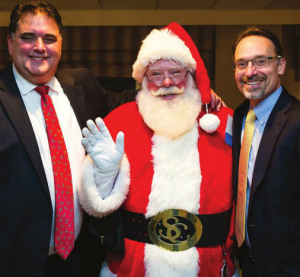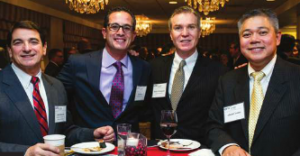As Seen in CFO Studio Magazine Q4 2015 Issue Cover Story
TAKING INSPIRATION FROM AGRISCIENCE, CFO BERRY BIER IS TRIMMING, TENDING, AND GROWING BAYER’S U.S. SUBSIDIARY TO REAP REWARDS
In August of 2014, when the corn was high and ambitious American political figures were already jetting in and out of Iowa prior to the first big test in the 2016 election race, Bayer Corporation CFO Berry Bier made his own trip to the state. He, too, was interested in meeting Iowa farmers face-to-face, but his purpose differed significantly from the politicians’. They were testing the waters for presidential runs. Bier, plucked 10 months earlier from the global headquarters of Bayer AG in Leverkusen, Germany, to become CFO of the Pittsburgh, PA–based U.S. organization, wanted to meet customers and find out from them how growers use Bayer CropScience products. For Bier, such exchanges were every bit as important as a politician’s pressing of the flesh.
The growers he met showed him two side-by-side plots of corn. One was treated with Bayer Sonata™, a biological product, and the other was untreated. The first exhibited green-husked corn bursting with kernels, and it demonstrated to Bier that Bayer was creating value for its customers. He could now better imagine how the businesses in which Bayer invests are improving lives and livelihoods.
That trip came just prior to an extraordinary period, during which Bier was responsible for spinning off part of Bayer. CFOs often have the opportunity to help shape their company through M&As or divestment, but Bier had a high-profile carve-out to accomplish on a short deadline. In achieving his goal, he found it useful to look up from the flowcharts and spreadsheets and envision … cornfields.
Bier and his carve-out team were fundamentally renewing the 150-year-old Bayer’s focus on life sciences: health care and crops.
Shaping the Company
On Oct. 30, 2014, just one year into his new job, Bier was given the task of spinning off one of Bayer’s three major product areas, MaterialScience. This would leave HealthCare (pharmaceuticals for humans and animals) and CropScience (including crop protection products, growth stimulants, and seeds that need less water or that are pesticide resistant). MaterialScience, which makes high-tech polymers, would then no longer compete for resources with the two other business areas. Though it would remain a subsidiary of Bayer AG, MaterialScience, with the new name of Covestro, would be removed from the U.S. corporation entirely and would have its own access to capital markets. (Subsequently, 31 percent of Covestro has been floated on the German stock market.)
Bier took up his role as project leader, and was given two months to clear the first hurdle: executing the legal separation by a Jan. 1 deadline. The target date for the spin-off to begin operating separately was Sept. 1, 2015. Bier calls this assignment one of the biggest challenges of his career. “You are separating about a third of your sales,” he says. “If we are a $50 billion company and you spin off $15 billion of that, that’s a big undertaking. Such a company needs a fully fledged organization.”
He had to divide functions across the whole company, including finance, HR, communications, IT, supply chain, procurement, and sales. He says, “That’s a huge task, but also really exciting.” In addition, he had to start the registration process and transfer contracts with suppliers and customers.
He began by assembling a team, building project plans and a timeline, and then moving on to execution. At that point, the team had to “deliver on all these different action items, and there [were] always things coming up. So you have to be very flexible and pragmatic to solve these things.”
Among these difficulties: reluctance on the part of some suppliers to shift their agreements with Bayer to Covestro. “We had to find ways to convince them, and we had to find ways both companies can operate separately as of Sept. 1,” he says. He praises the spirit of cooperation on his team from day one. But as project leader, when tough choices have to be made, “you have to make a decision.” The team can only do so much.
As he was heading up the project to carve out MaterialSciences, Bier was simultaneously part of the steering committee for the integration of a $14.2 billion acquisition. That process had begun in April 2014, when Bayer beat another bidder to acquire Merck’s Consumer Care business, which includes Claritin®, Coppertone®, Dr. Scholl’s®, and MiraLAX®. Added to Bayer’s aspirin juggernaut, the brands would significantly strengthen the company in its HealthCare area. The integration continued until the end of June 2015 and, depending on how it is measured, established Bayer as either the No. 1 or No. 2 company in the U.S. non-prescription medicines market.
The company’s new profile makes Bayer highly reliant on its pharmaceutical products for earnings. It has best-selling drugs for hypertension, cancer, and hemophilia, among other categories. But the pharmaceuticals industry, Bier says, is a “risky business.” This is especially true of companies that are in a stage of their business life cycle where they have numerous successful products and high growth but are nearing a critical moment in their history, when an important patent will expire and “you lose a significant part of your sales,” he says.
Now that Bayer is solely a life-sciences company, having “cut off [its] chemical legs,” the CFO says more M&As will almost surely occur. To explain why, Bier points to the hard realities of developing a pharmaceutical product: It can easily cost $1 billion to $2 billion to bring a new drug to market, says Bier, and the drug’s patent subsequently expires in as few as 10 years.
Creating Value by Being Partners
Bier says the most challenging part of his position is not, as one might expect, working out a complex funding structure or working through tax issues. Rather, he contends, it’s the process of developing “a high-performing organization that is constantly able to respond to the challenges coming from the outside world onto the business, and that has the capability to create value by what it is doing.”
He says, “The real challenge is having an organizational setup with creative spirit but that also has the capability of being great business partners.”
In the past two years, he has worked to bring that type of mindset to his own organization through the recruitment of top business-school students from the likes of New York University, Duke University, and Carnegie Mellon University; through high-performance workshops; and through training in soft skills, such as delivering constructive feedback up- and downwards.
Although innovation is the lifeblood of a company developing pharmaceuticals, Bier can’t budget for development of a specific cancer treatment. He says, it’s more like this: “You know you have so much product in the market generating so much sales, and a certain portion of that you’re willing to spend for your R&D.” Certainly there are benchmarks on R&D spending, but Bayer doesn’t attempt to create all its products from scratch. Instead, like most pharma companies, it spots opportunities to acquire small, entrepreneurial firms. (See “Funding the Future” at right, for more on Bier’s strategy regarding R&D.)
Two Years In
Bier brought his family — his wife, Gudrun, to whom he has been married for more than 20 years, and two sons, now 12 and 13 — to Pittsburgh two years ago, from Cologne, Germany. “It’s great to see how well the family adjusted to the new environment,” he says. He’s passionate about his family and credits them with centering him and giving him the mettle to perform in the C-suite of a top global corporation.
There, Bier has not just a stake, but a big role in building the company. He was heavily involved during 2014 in designing the current strategy, together with the U.S. leadership team. That strategy relies on acquisitions, R&D partnerships, and the funding of promising new products. In pharma, you can’t think of your next breakthrough discovery as the product that will bring you growth in the 2020s, he says. You have to view that drug as just a way “to make up for the loss” when another wonder drug you’ve funded loses patent protection.
In Grinnell, IA, Bier recalls that he was amazed at the stark difference in appearance between treated and untreated crops. In the Crop Protection area of Bayer’s business, says Bier, “increasing yields to ensure that growers can meet their targets” is perfectly aligned with the company’s mission, Science for a Better Life. “We can help to meet nutritional demands and feed the world today and in the future,” he says.
The potential for significant ups and downs in the company’s chief areas of concentration — pharmaceuticals and food production — suggest that there will be little stability in the months to come. Bier, though, seems unconcerned. He says that the most exciting part of being a CFO is having the opportunity to focus on both the near-term and long-term planning for the company.
It’s his job, Bier says, to create value. To do that, a CFO must “understand what the success factors of the business are, and then think about how you can contribute to that.” Sometimes that means walking around a cornfield and having all the pieces fall into place.







